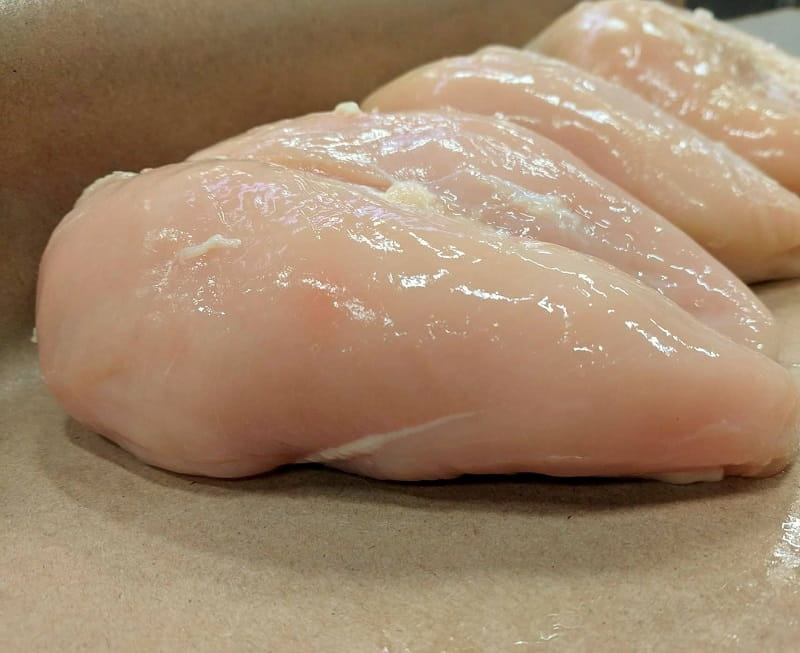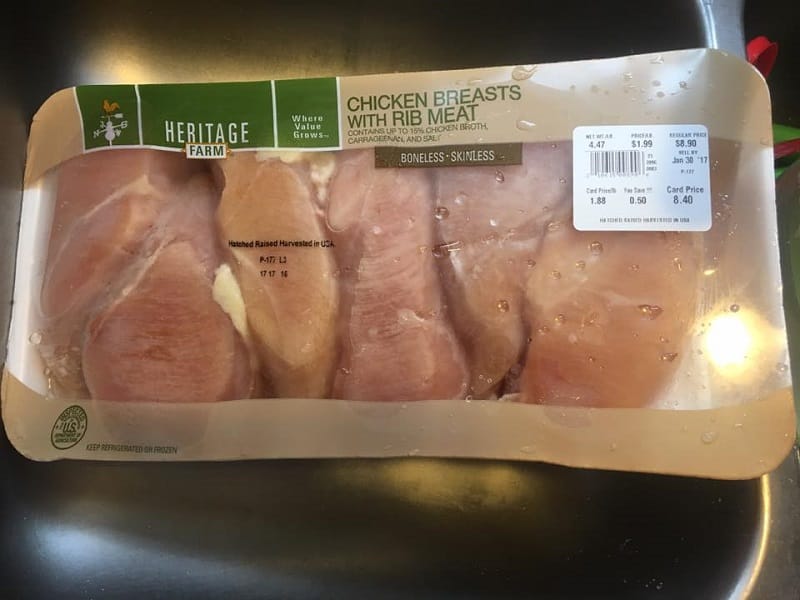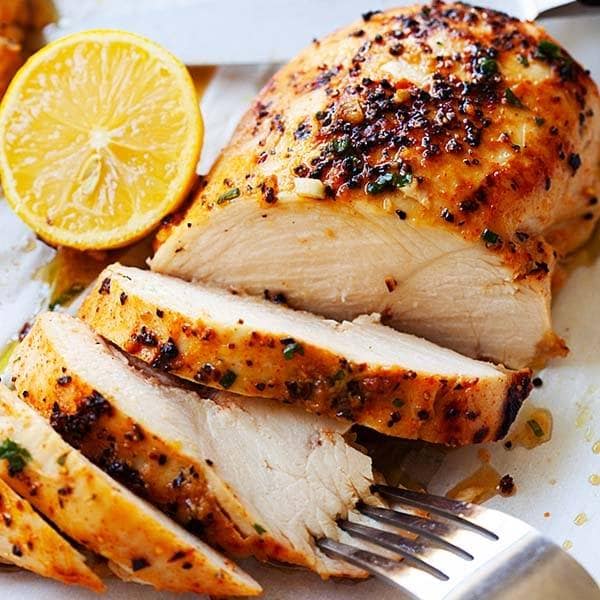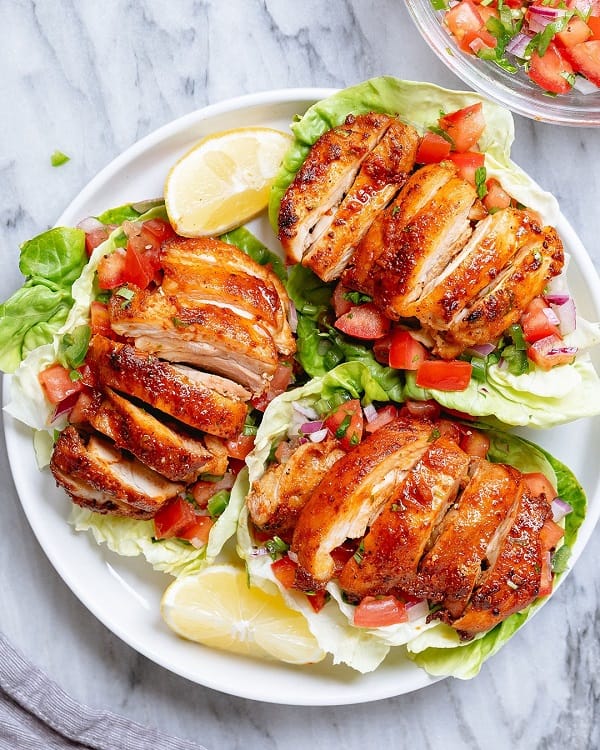Chicken is one of the most commonly consumed meats all around the world. There are infinite ways to prepare and enjoy this protein powerhouse, from traditional roast chicken to grilled, baked, or fried chicken dishes. But when it comes to cooking chicken, it’s important to understand how much meat you are working with. Many recipes call for specific measurements of chicken, but how many chicken breasts in a pound? This is a question that many home cooks and chefs often ask. This article will explore the answer to this question and provide some useful tips on cooking chicken breasts perfectly.
Factors That Can Impact Chicken Breast Weight

Have you ever noticed the wide range of weights that chicken breasts can vary? This can be due to various factors impacting chicken breast weight. Now, we will explore some of these factors and what they mean for the weight and quality of your chicken breasts.
- Breed of Chicken: Different breeds of chickens have different characteristics, including size and weight. For example, the Cornish Cross is a breed specifically bred for meat production and can have a dressed weight of up to 8 pounds. On the other hand, some heritage breeds of chickens, like the Rhode Island Red, tend to have smaller and leaner breasts. When purchasing chicken breasts, it’s essential to consider the breed of chicken to understand the potential weight range.
- Age of Chicken: Younger chickens tend to have smaller breasts, while older chickens have larger breasts. However, this comes at the expense of the quality of the meat, as older chickens tend to be tougher and less flavorful. For the best quality meat, it’s recommended to purchase chicken breasts from around 6-8 weeks old chickens.
- Gender of Chicken: Believe it or not, the gender of the chicken can also impact the size and weight of the breasts. Roosters tend to have larger and tougher breasts, while hens have smaller and more tender breasts. This is because roosters have more muscle mass in their chests, while hens have more fat.
- Diet of Chicken: Chickens fed a high-protein diet tend to have larger breasts, while chickens fed a high-carbohydrate diet tend to have smaller breasts. Additionally, chickens allowed to graze and forage for their food tend to have leaner and more flavorful meat. When purchasing chicken breasts, it’s important to consider the diet of the chicken to understand the potential weight range and quality of the meat.
- Processing Method: When processed, chickens are typically eviscerated, and their heads, feet, and wings are removed. This process can result in weight loss, as these parts account for up to 30% of the chicken’s overall weight. Additionally, chickens that are processed using mechanical methods, like those used in commercial processing plants, can result in bruising and damage to the meat, impacting its quality.
How Many Chicken Breasts In A Pound?
When cooking with chicken breasts, the number of pieces you’ll get from a pound can vary depending on several factors. Factual data shows that boneless skinless chicken breasts typically yield around 3-4 individual pieces per pound. However, this number can change depending on the size and weight of the chicken breasts.
The number of pieces you’ll get per pound may differ if you buy organic or bone-in chicken breasts. On average, a pound of chicken breasts will give you two large pieces or 3-4 smaller ones. It’s essential to consider the serving size versus weight to ensure you’re getting the right amount of protein in each serving.
How Many Chicken Breasts With The Bone-In Are In A Pound?

If you’re wondering how many chicken breasts with the bone-in are in a pound, the answer is around two to three breasts. An average bone-in and skin-on chicken breast weigh about 8.2 ounces. This means that in one pound or 16 ounces, you can expect to have approximately two to three chicken breasts with the bone-in.
However, it’s essential to remember that this number can vary depending on the size and weight of the chicken breasts. So, if you plan to cook a pound of bone-in chicken breasts, you can expect to have two to three medium-sized pieces to work with.
How Many Chicken Breasts With The Bone-Less Are In A Pound?
Regarding boneless, skinless chicken breasts, the average person can expect to find around 2-3 breasts in a pound. However, this number can vary depending on the size of the individual breasts.
For example, if the chicken breasts weigh around 6 ounces each, roughly 2.67 chicken breasts are in a pound. On the other hand, a 16-ounce pound of boneless, skinless chicken breasts typically contains around 3-4 individual breasts.
It’s important to note that these numbers are estimates, and the number of chicken breasts in a pound may vary based on weight, size, and preparation method. Regardless of the exact number, you can always count on delicious and nutritious grilled chicken when you stock up on boneless, skinless chicken breasts!
How Much Does 1 Chicken Breast Weigh?

When cooking chicken, it’s important to know how much each piece weighs. Specifically, when considering chicken breast weight, one chicken breast will weigh between 6 to 8 ounces on average. It’s worth noting that the weight can vary based on factors like whether or not the chicken is boneless or skinless.
Smaller chicken breasts can weigh 4 to 5 ounces, while larger ones can weigh up to a pound. It’s also worth noting that cooked chicken breast will generally weigh less than uncooked chicken breast, as it loses moisture during cooking.
With The Bone-In
- If you plan on cooking chicken breast with the bone-in, you may wonder how much it will weigh. On average, a bone-in chicken breast will weigh around 12 ounces, though this can vary depending on the size of the chicken.
- It’s important to note that bones add weight to the overall amount of meat so that a bone-in chicken breast may weigh more than its boneless counterpart. However, the bone also adds flavor and nutrients to the meat, making it a popular choice for many recipes.
With The Bone-Less
- On average, a boneless and skinless chicken breast weighs around 6 to 10 ounces, but it can be as small as 4 ounces or as large as 8 ounces. However, keep in mind that bones add weight to the overall amount. If you are trying to portion your meat, you can typically fit around four boneless chicken breasts into one pound.
- Remember that the weight can also vary depending on the size of the individual chicken breast. So, next time you are at the grocery store or planning a meal, consider the weight of the chicken breast to ensure you get the right amount.
Read more:
- How Long To Bake Chicken Breast At 400
- What Does Undercooked Chicken Look Like
- How Long Can Frozen Chicken Sit Out
Different Types of Chicken Breasts
If you’re a chicken lover, you’re probably aware that many chicken breasts are available. Knowing which is best for your recipe, from bone-in to boneless, skin-on to skinless, and even organic options, can be hard. Today, we’ll break down the different types of chicken breasts and what makes each unique.
Bone-in Chicken Breasts
- Bone-in chicken breasts are exactly what they sound like – chicken breasts with the bone still attached. The bone adds flavor and moisture to the chicken, making it a popular choice for grilling and roasting.
- The downside to bone-in chicken breasts is that they take longer to cook than boneless varieties and can be more difficult to eat.
Boneless Chicken Breasts
- Boneless chicken breasts have become increasingly popular in recent years, as they are easier to cook and eat than bone-in varieties. They are also a good choice for recipes that call for shredded chicken, as they can easily be pulled apart once cooked.
- The downside to boneless chicken breasts is that they can be dry if overcooked, so keeping an eye on them while cooking is essential.
Skin-on Chicken Breasts
- Skin-on chicken breasts are chicken breasts with the skin still attached. The skin adds flavor and helps keep the chicken moist while cooking. It also crisps up nicely when seared or roasted.
- However, the skin can add extra fat and calories to the chicken, so it may not be the healthiest option.
Skinless Chicken Breasts
- Skinless chicken breasts are chicken breasts with the skin removed. They are a healthier option than skin-on chicken breasts, as they are lower in fat and calories.
- However, they can be dry if overcooked, so it’s important to cook them properly to ensure they stay moist.
Organic Chicken Breasts
- Organic chicken breasts are chicken breasts that come from chickens raised without antibiotics or hormones and fed organic feed. They are healthier than conventionally raised chicken breasts, as they have not been exposed to potentially harmful chemicals.
- However, they can be more expensive than conventional chicken breasts.
How Much Does A Pound Of Chicken Breasts Cost?

If you’re wondering how much a pound of chicken breasts costs, the answer can vary depending on where you shop and the quality you’re after. According to the U.S. Bureau of Labor Statistics, the average price for boneless chicken breasts in the United States was $4.35 in 2022.
While some may consider that price reasonable, others may turn to butcher shops or specialty stores that offer higher quality chicken breasts for anywhere from $6 to $10 per pound.
On the other hand, according to the USDA, those looking for a budget-friendly option may consider purchasing whole chickens, which currently average $1.28 per pound nationwide. Of course, prices can fluctuate based on various factors, such as size and quantity purchased, but it’s good to have an idea of the average price range when shopping for chicken breasts.
Which is Healthier- Chicken Breast or Thigh?
When it comes to choosing between chicken breast and chicken thigh, there is no easy answer. Both cuts of chicken have their unique nutritional benefits and drawbacks. Here, we will explore the differences between chicken breast and thigh and help you decide which is healthier.
Chicken breast is often touted as the healthiest part of the chicken because it is leaner and has fewer calories than other cuts. A 3-ounce serving of skinless, boneless chicken breast contains about 140 calories, 3 grams of fat, and 26 grams of protein. It is also a good source of vitamins B6 and B12, niacin, and phosphorus.
However, chicken breast is not without its downsides. Because it is so lean, it can be dry and flavorless if not cooked properly. It also has less flavor than other cuts of chicken, which can be a turnoff for some people.
On the other hand, the chicken thigh is a darker, fattier meat that is often considered less healthy than chicken breast. A 3-ounce serving of skinless, boneless chicken thigh contains about 170 calories, 9 grams of fat, and 19 grams of protein. It is also a good source of vitamins B6 and B12, niacin, and selenium.
Chicken thigh has more tender and flavorful meat than chicken breast despite its higher fat content. It is also more forgiving when it comes to cooking, as its higher fat content makes it less likely to dry out.
So, which one is healthier for you? The answer depends on your individual dietary needs and preferences. If you want to lose or maintain a healthy weight, the chicken breast may be the better choice because it is lower in calories and fat. However, chicken thigh may be the way to go if you want more flavorful and tender meat.
It is also worth noting that the healthiness of chicken breasts and thighs can be impacted by how they are prepared. Fried chicken, for example, is high in calories and fat regardless of whether it is made with breast or thigh meat. Grilled or baked chicken, on the other hand, can be a healthy and delicious option regardless of the cut.
FAQs
How Many Calories Are In 1 Lb Of Chicken Breast?

Chicken breast is a popular choice for many who are conscious about their diet and trying to maintain a healthy lifestyle. In terms of calories, 1 pound of chicken breast packs quite a punch, totaling 720 calories per pound. However, the number of calories may vary depending on factors such as whether or not the chicken breast has skin and how lean the meat is.
For example, a cut of chicken breast that is extra lean may contain as little as 187 calories per pound, while one that is slightly fattier may have closer to 200 calories per pound. Despite the varying calorie counts, chicken breast is an excellent source of protein and can be incorporated into a balanced and nutritious diet.
How Many Chicken Breasts In 10 Pounds
Did you know a 10-pound bag of frozen chicken breasts contains around 22 pieces? The average weight of a frozen chicken breast is 7 ounces, so it’s no surprise that a 10-pound bag would have quite a few pieces in it.
When cooking with chicken breasts, a recipe that calls for one pound of cooked chicken will require around 4 and a half to 5 breasts. However, the number of breasts you’ll need can vary based on the weight of each piece. Large-sized chicken breasts can weigh up to 12 ounces each, meaning you’d only need 1.6 pieces for a pound, while smaller 4-ounce options would require 4 pieces.
It’s important to note that the number of pieces per pound can vary, but on average, there are around 4 chicken breasts in a pound of raw meat.
How Many Chicken Breasts Do I Need For 2 People?

When planning a meal that includes chicken as the main entree, it’s important to know how many chicken breasts you need for your intended number of guests. You’ll want to plan on approximately one pound of boneless chicken breasts if you’re serving two people. This should give you around two to three chicken breasts, a generous serving size for two people.
However, if you or your guests are big eaters, you may want to consider increasing the number of chicken breasts to three per person. Regardless of how much chicken you choose to serve, it’s important to remember that there will be some water loss after the meat is cooked. So if you’re concerned about having enough chicken, cooking a few extra breasts just in case is always a good idea.
Conclusion
In conclusion, the answer to the question “How many chicken breasts in a pound?” can vary, but it is typically two to three boneless, skinless chicken breasts or one to two bone-in chicken breasts. However, it is best to purchase chicken by weight rather than by the number of chicken breasts to ensure enough meat for your dish. Always consider the size of the chicken breasts when cooking to achieve the best taste and texture. So, the next time you are at the grocery store or planning a meal, remember these tips and enjoy your delicious chicken dish!
References:
- https://www.verywellfit.com/how-many-calories-in-chicken-breast-3495665
- https://www.eatthismuch.com/food/nutrition/chicken-breast-1-lb,2167951/
- https://www.ams.usda.gov/mnreports/pywretailchicken.pdf
- https://cooking.stackexchange.com/questions/32336/what-is-the-percentage-by-weight-of-meat-in-a-split-chicken-breast

Hey readers! Chip Holland here, and I’m a Manager of this website. My passion for writing about it only matches my passion for BBQ. Follow my blog for mouth-watering recipes, tips, and tricks for the perfect smoke, grill, and BBQ. I’m sure you won’t be disappointed!
